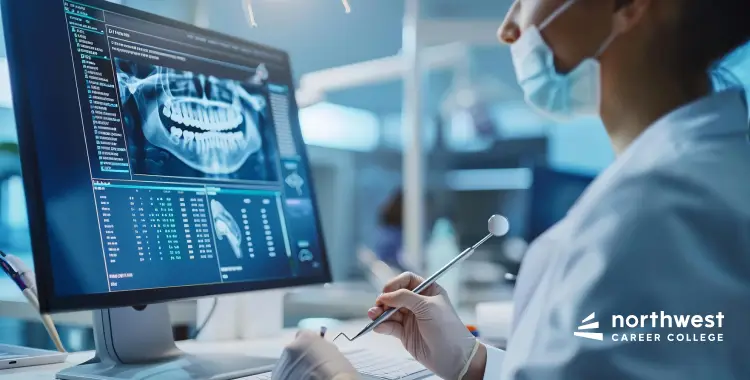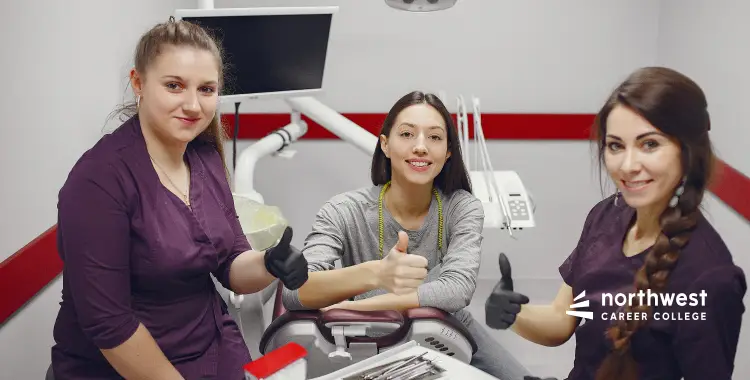A Beginner’s Guide to Procedural & Diagnostic Coding in the Dental Office
- November 4, 2025
- 843 views
- 4 min read
Procedural and diagnostic coding is essential for anyone entering the dental industry. Suppose you are pursuing a career as a dental assistant, office manager, or billing specialist. Suppose you plan to pursue a career as a dental assistant, office manager, or billing specialist.
In that case, you must know how to navigate dental codes to ensure accurate billing, efficient insurance processing, and compliance with industry standards.
This beginner’s guide will break down the basics of dental coding, highlight the key differences between procedural and diagnostic codes, and offer practical tips to help you feel more confident working with patient records and insurance claims.

Table of Contents
What is Dental Coding?
Dental coding is a set of letters and numbers that tell what is done during a dental appointment.
- Procedure performed (such as a filling or cleaning)
- Why did the patient require it
- How much does it cost
- Insurance covered
Two broad categories of dental codes exist:
- Procedure Codes (CDT Codes) – These denote what treatments were performed.
- Diagnostic Codes (ICD-10 Codes) – These indicate the reason the dentist did it.
Consider them a shared language that the office, insurance organization, and patient comprehend.
Why is coding important?
Coding can be tough, as it may sound too technical, but it’s significant in dental Practice. In case of the wrong codes:
- Insurance will not cover the treatment
- They can be billed in error.
- The office can lose money
- Physicians may be in legal jeopardy over blunders
Accurate coding ensures that the office operates smoothly and the patients receive what they require without confusion about their bills.
What is Procedural Codes (CDT)?
CDT stands for Current Dental Terminology. These codes of procedure apply in all American dental offices. They begin with the letter D and four numbers.
Some of these common examples include:
- D0120 – Periodic oral exam (routine checkup)
- D1110 – Adult teeth cleaning
- D2330 – Filling one front tooth surface
- D2750 – Crown for tooth
Each of these codes indicates to the insurance company:
“This is what was accomplished during the visit.”
This may sound confusing at first, but don’t worry. During your practical training in finding, interpreting, and applying these CDT codes to actual dental cases, you will learn all that the Northwest Career College provides.
What Are Diagnostic Codes (ICD-10)?
Diagnostic codes explain why the treatment was performed. They utilize the ICD-10 methodology, which is being employed in medical and dental facilities worldwide.
For instance:
- K02.5 – Deep tooth decay
- K05.1 – Gum disease
- K00.5 – Delayed eruption of teeth in children
The correct use of the ICD-10 code defines the reason for the treatment. This is useful for insurance and record-keeping purposes.
You don’t need to memorize all of the codes. However, you must learn to look them up and utilize them appropriately.
5 Tips to learn to code
Beginning something can be intimidating. However, starting dental coding doesn’t have to be difficult. The following are some helpful hints to start with:
- Break it down – Work with one code type at a time
- Flashcards – Make memorization of standard codes a habit
- Ask questions – Your NCC teachers are here to assist you
- Practice with actual cases – Obtain practical examples in class
- Keep up to date – Codes do vary annually, so it is essential to be current
Keep in mind that even dental professionals start from the beginning. Given proper training and assistance, you can become a dental coding master in a few months.
Why Dental Coding is Such a Super Skill to Acquire
As a Dental Administrative Assistant, you’re a good asset to the dental Practice because of your coding skills. You bring together the dentist, the patient, and the insurance company and ensure that everything is fair and accurate.
In addition, you’ll be more employable since offices recruit those who can do both front desk and dental coding work. This translates to greater job prospects and increased compensation.
Earn Your Certification in as Few as 3 Months
At Northwest Career College, we simplify getting you into the dental industry, regardless of whether you’ve had prior experience working in an office.
- Finish in only 3 months
- Master actual-world programming and dental software
- Expand your value in dental offices, hospitals, and clinics
- Learn with instructors who put you first
Whether you’re a newcomer to the workforce or changing careers, dental coding is a valuable skill that will never go out of demand.
Enroll now and start down the path to being a reliable Dental Administrative Assistant today!





